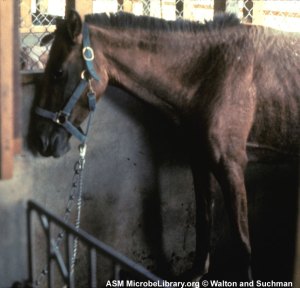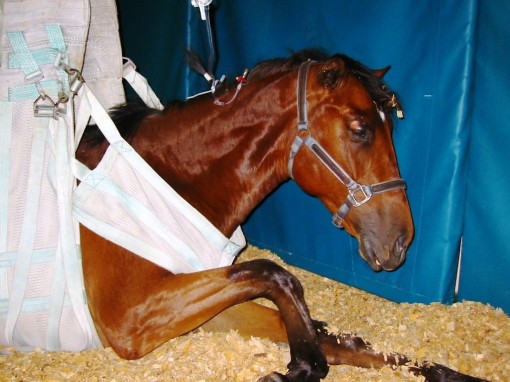
Eastern Equine Encephalitis Virus (EEEV)
Family- Togaviridae
Genus- Alphavirus
*It is closely related to Western Equine Encephalitis Virus (WEEV) and Venezuelan Equine Encephalitis Virus (VEEV)
Category of Pathogen
The EEEV genome consists of a nonsegmented, single-stranded, positive-sense RNA of approximately 11.7 kb. The virus is spherical and has a diameter of 60-65 nm.
Name of the Disease caused by the pathogen
Eastern Equine Encephalitis (EEE)
Symptoms of Infection
A horse will begin to develop symptoms within five days of contracting the disease and will die within 48-72 hours after symptoms are first exhibited. Symptoms result from brain inflammation (encephalitis) and include fever, sleepy appearance, erratic behavior, a weak and staggering gait, loss of coordination, muscle twitches of the head, neck, shoulder, and flank, and seizures.
Primary Host
The Culiseta melanura, Ochlerotatus s ollicitans, and Coquillettidia perturbans mosquitoes are the primary hosts (and vectors) of EEE.
Other Hosts
Reservoir Hosts
Reservoir hosts of EEE include various song birds like the bluejay, tufted titmouse, chickadee, catbird, and cardinal. Reservoir hosts are hosts that conserve the pathogen with no expression of the pathogen. *Note- there is no immediate way to tell if a bird is carrying the disease unless lab testing is done because the bird expresses no symptoms.
Dead End Hosts
Dead end hosts of EEE include horses, humans, pheasants, quail, ostriches, emus, dogs, and cats. Dead end hosts are hosts that do not transmit the pathogen to the primary host. These dead end hosts do not accumulate enough of the virus in their blood streams to infect non-infected mosquitoes.
Route of Transmission
Vector borne via mosquitoes
Transmission Cycle
1) A female mosquito feeds on an EEEV infected bird (the virus is eliminated by antibodies in the bird after 2-5 days).
2) After a latent period of 48-72 hours, the newly infected mosquito begins to transmit the viral EEE pathogen to other hosts (either reservoir hosts or dead end hosts).
3) Once infected with EEEV, mosquitoes are infected for life, meaning that they will disperse some of the virus with each blood meal until they die.
Ro
Unknown
Prevalence
The prevalence of EEE cases per year is unknown. However, in the 2009 EEE season, 296 horses died in the United States. The annual EEE season lasts from mid summer to late autumn.
Cases of Eastern Equine Encephalitis by State in 2009
Alabama- 23
Arkansas- 2
Georgia- 44
Louisiana- 28
Massachusetts- 1
Maryland- 1
Maine- 15
Mississippi-43
North Carolina- 23
New Hampshire- 3
New Jersey- 6
New York- 7
South Carolina- 14
Texas- 4
Virginia- 9
Geographic Constraints
EEE is geographically constrained because of the species of mosquito that carry the virus. These mosquitoes propagate near salt-water wetlands, so cases of EEE are found from New England to Florida and along the Gulf Coast.
Generation Time
Although the generation time is unknown, it is understood that EEEV replicates in lymphoid tissues and infects the central nervous system. It is difficult to find the generation time of EEEV because of it’s varied (48-72 hours) latent period and indefinite infectious period in the vector host.
Mortality Rate
75-90%
Morbidity Rate
The 10-25% of horses that do not die are typically euthanized due to the onset symptoms of EEE that include constant disorientation, regular seizures, and staggering gait. Euthanization for the surviving horses is the norm because the recurring symptoms cause so much suffering. There is no evidence that supports that a horse will survive if it is not euthanized.
Prevention
Unvaccinated horses are highly susceptible to infection, and an annual vaccination is recommended. The first vaccination in adult horses is to be followed by a second injection three to four weeks after the first. Foals are to be vaccinated at 4, 5, 6, and 12 months and then annually thereafter. Only a veterinarian should give this vaccine because proper handing and administration are extremely necessary. It is also important to reduce the number of water receptacles on horse property and to flush troughs weekly during the EEE season in order to reduce mosquito risk around the paddock area.
Immunity
Immunity to EEEV is only artificial through the annually administered equine vaccination. These vaccinations should be administered in the spring to optimize protection.
Economic Impact
Although the economic impact is unknown, the financial impact of the loss of a horse is obviously high.
History
EEEV was first isolated in horse brains in 1933 in the United States after an outbreak in the northeast. Due to the limited technology, there is no evidence that supports that the disease was around before 1933.
Nifty Stuff
It is difficult for a horse to be declared a victim of Eastern Equine Encephalitis, simply because the symptoms could be from a number of other diseases or disorders. Consequently, veterinarians must perform either a full autopsy of the horse or will have the brain extracted for examination. A full autopsy will result in the finding of lesions in the cerebral cortex, thalamus, hypothalamus, and C1-C4 of the spinal cord; blood vessels will be swollen; axons will be shrunken; and the lungs will have eosinophilic fluid flooding the alveoli.
Many horse owners do not call a veterinarian to report a case of Eastern Equine Encephalitis for fear of quarantine…But quarantine is not required because the disease cannot be transferred from horse to horse or horse to human.
Sources
Arrigo NC, Adams AP, Weaver SC. Evolutionary Patterns of Eastern Equine Encephalitis Virus in North Versus South America Suggest Ecological Differences and Taxonomic Revision. Journal of Virology, 84:2, p1014-1025. January 2010.
Crans WJ. Questions Regarding Eastern Equine Encephalitis and Horses. Rutgers Cooperative Research & Extension Fact Sheet FS737. October 1993.
Eastern Equine Encephalitis and Horses. Louisiana State University Ag Center Research and Extension. October 2005.
Franklin RP, et al. Eastern Equine Encephalomyelitis Virus Infection in a Horse from California. Emerging Infectious Disease, 8:3. March 2002.
Rey JR, Rutledge R. Eastern Equine Encephalitis. University of Florida Extension Fact Sheet ENY-652.









